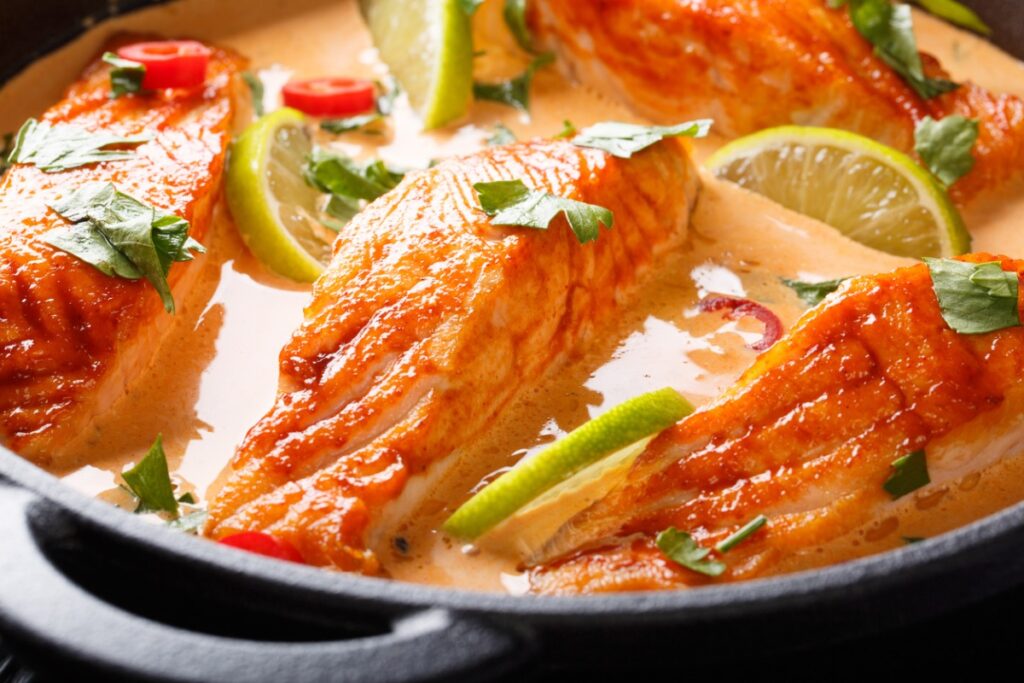These Thai Coconut Curry Salmon fillets are a perfect dinner during Lent. The warm spices in the coconut curry sauce are so comforting and full of flavor – just what you need while the weather is still a bit chilly outside.
Thank you for reading this post, don't forget to subscribe!

This dish screams for steamed white rice, but I like to serve it with Basic Biryani Rice, Sweet And Sour Shaved Brussels Sprouts Salad, Easy Sugar Snap Peas, and a dish of Creamy Matcha Lychee Ice Cream for a meal that is hearty and satisfying.
Thai Coconut Curry Salmon Fillets
I have family members who don’t really care for fish. They’ll happily eat shellfish, but no fish other than fish sticks or canned tuna. Makes for a really long Lenten season. How many meals of fish sticks and mac and cheese can you enjoy?
This recipe works because the salmon is pan-seared and then lightly poached in a zesty, very flavorful sauce. I also used Keta salmon, which has a lower fat content, so its flavor is milder.

Types Of Salmon
Chum – also called Keta or dog salmon. It’s called dog salmon because of its canine-like teeth. Keta allows the fish to avoid the negative connotations of ‘chum’. Keta is a smaller salmon with pale to medium-colored flesh, lower fat content, and mild flavor. It’s often sold canned or frozen. The Chum’s roe is considered a delicacy in many cuisines. It is larger and tastier than other types of salmon roe. Chum salmon is mostly harvested from Alaskan waters.
Steelhead – this fish is actually trout. They have orange flesh like salmon, but the flavor is milder than other salmon types yet more intense than other trout varieties.
Sockeye – This variety has bright red-orange flesh and a deep, rich flavor (fishier). Sockeye is often sold smoked, They are smaller, leaner, and cheaper in price than King salmon. They’re mostly caught in Alaskan waters.
King salmon – also known as Chinook. This is considered to be the best tasting of the salmon varieties. It has a high-fat content with flesh that ranges from pale to a deep red color. Its flavor is considered to be bold and rich (fishier). The fish is large, often over 100 pounds, and harvested from Southern California to Northern Alaska.
Coho salmon – also called silver salmon because of their very silvery skin. They have a medium fat content, bright red flesh, and a more delicate texture than King salmon, but a similar bold flavor. Their small size allows them to be cooked whole. Coho is commonly found in Alaskan waters and in the Northern Pacific.
Pink salmon – also known as humpback or humpies because of the distinctive hump on their back when they spawn. This is the most common Pacific salmon. They have very light-colored flesh with low-fat content and mild flavor. Pink salmon is often sold canned, smoked, fresh, or frozen and harvested primarily on Alaskan waters.

Ingredients Needed
- Salmon – I used Keta salmon because of its very mild flavor. Choose the variety that your family enjoys. Be sure to use fillets of similar thickness so that they cook at the same rate.
- Kosher salt and black pepper
- Light-tasting oil – I like using coconut oil to enhance the coconut flavor in the recipe, but olive oil, vegetable oil, or canola oil would also work.
- Onion, garlic, Thai chiles, limes
- Ginger and lemongrass – I like to use the paste for each. These can be found in the fresh herb section of your grocery store.
- Thai red curry paste – I used Thai Kitchen Red Curry Paste. It has a bold, but mild flavor.
- Coconut milk – Use full fat. I’ve found some brands to be very watery. I like using the Thai Kitchen Full Fat Coconut Milk. It has a fatty cream layer at the top. You want to scrape all of that goodness and the liquid into your skillet for the sauce.
- Soy sauce – I used a low-sodium soy sauce.
- Fish sauce – this adds a lovely umami flavor, and some saltiness, but not a fishy taste. Yes, it smells fishy in the bottle, but the flavor mellows when it cooks. If you don’t want to use fish sauce, Worcestershire sauce will work.
- Brown sugar – you could also use honey.
- Cilantro or basil – as a garnish.
Steps To Make This Recipe
- Pat the salmon fillets dry with paper towels. Get them as dry as possible. This will help them to sear in the pan. Season all sides of the fillets with salt and pepper.
- Heat oil in a skillet and sear the salmon on both sides. The fish will release easily from the pan if it has been seared fully. If it sticks, let it sear another minute or two. Remove the fillets from the pan.
- Saute the vegetables in the oil left in the pan.
- Stir in the ginger, lemongrass, chile paste, coconut milk, soy sauce, fish sauce, lime juice, and brown sugar. Simmer until thickened.
- Return the fish to the pan and poach for 5 minutes, basting the top of the fillets with the sauce.
- Garnish and serve over rice.

More Seafood Recipes To Try During Lent
- Baked Parmesan Scallops
- Scallops Bruno
- Seared Sea Scallops With Lemon Cream Sauce And Balsamic Drizzle
- Honey Bourbon Glazed Scallops
- Stir-Fry Noodles And Scallops
- Grilled Chile Lime Shrimp
- Shrimp Cocktail
- Light And Crunchy Fried Shrimp
- Spaghetti Squash Shrimp Scampi
- Shrimp Fra Diavolo
- Alabama Shrimp And Grits
- Classic Shrimp Etouffee
- Spicy Shrimp Creole
- Mexican Shrimp Ceviche
- Spicy Shrimp Tacos With Sweet And Crunchy Slaw
- Tavern On The Green Crab Cakes
- Easy Steamed Crab Legs
- Seafood Enchiladas (copycat Chi Chi’s)
- Thai Fish Cakes
- Lemon Garlic Roasted Swordfish
- Roasted Salmon And Lentils
- Crunchy Batter Fried Cod

Thai Coconut Curry Salmon Fillets
- Author: Millie Brinkley
- Total Time: 40 minutes
- Yield: 4 servings 1x
Description
These Thai Coconut Curry Salmon fillets are a perfect dinner during Lent. The warm spices in the coconut curry sauce are so comforting and full of flavor – just what you need while the weather is still a bit chilly outside.
Ingredients
4 salmon fillets (about 1½ – 2 pounds)
Kosher salt and freshly ground black pepper
2 tablespoons coconut oil or olive oil
1 small sweet onion, finely chopped
2 large garlic cloves, minced
1 small red Thai chile, seeded and finely chopped (optional)
1 tablespoon ginger, minced
2 teaspoons lemongrass, minced
2 tablespoons Thai red curry paste
1 (13.5 ounces) can full-fat coconut milk
1 Tablespoon soy sauce
1 tablespoon fish sauce
2 tablespoons fresh lime juice
2 tablespoons brown sugar
Sliced red Thai chile, as garnish
Fresh lime slices, as garnish
Cilantro or basil sprigs, as garnish
Instructions
Pat the salmon fillets dry with paper towels. Season all sides of each fillet well with salt and pepper.
In a large skillet with deep sides, heat the oil over medium-high heat until shimmering – about 3 minutes.
Add the salmon fillets, skin side down, and sear for about 3 minutes. Flip and cook for another 3 minutes. The fish should be almost done. If the fish sticks to the pan, give it another minute or two to release naturally, don’t force it. Use a slotted spoon to remove the fish from the skillet to a plate and set aside.
Add the onion to the skillet and saute until translucent – about 2 minutes.
Toss in the garlic, minced red chiles, ginger, and lemongrass. Saute until fragrant.
Stir in the red curry paste until well combined and allow the spices to ‘toast’ for 1 minute.
Next, whisk in the coconut milk, soy sauce, fish sauce, lime juice, and brown sugar. Bring the mixture just to a boil, then reduce the heat to a simmer.
Cook the sauce for 5 minutes or until the sauce slightly thickens.
Nestle the salmon fillets into the sauce and spoon the sauce over the fillets.
Poach the salmon in the sauce, basting every minute, for 5 minutes.
Garnish with sliced red chiles, lime slices, and cilantro or basil sprigs.
Serve hot with steamed white rice.
- Prep Time: 15 minutes
- Cook Time: 25 minutes
- Category: Main Dish – Seafood
- Method: Braise
- Cuisine: Thai
Keywords: Thai coconut curry salmon fillets, Thai recipes, salmon fillets, Lent recipes, recipes for Lent, seafood recipes, Asian seafood recipes
